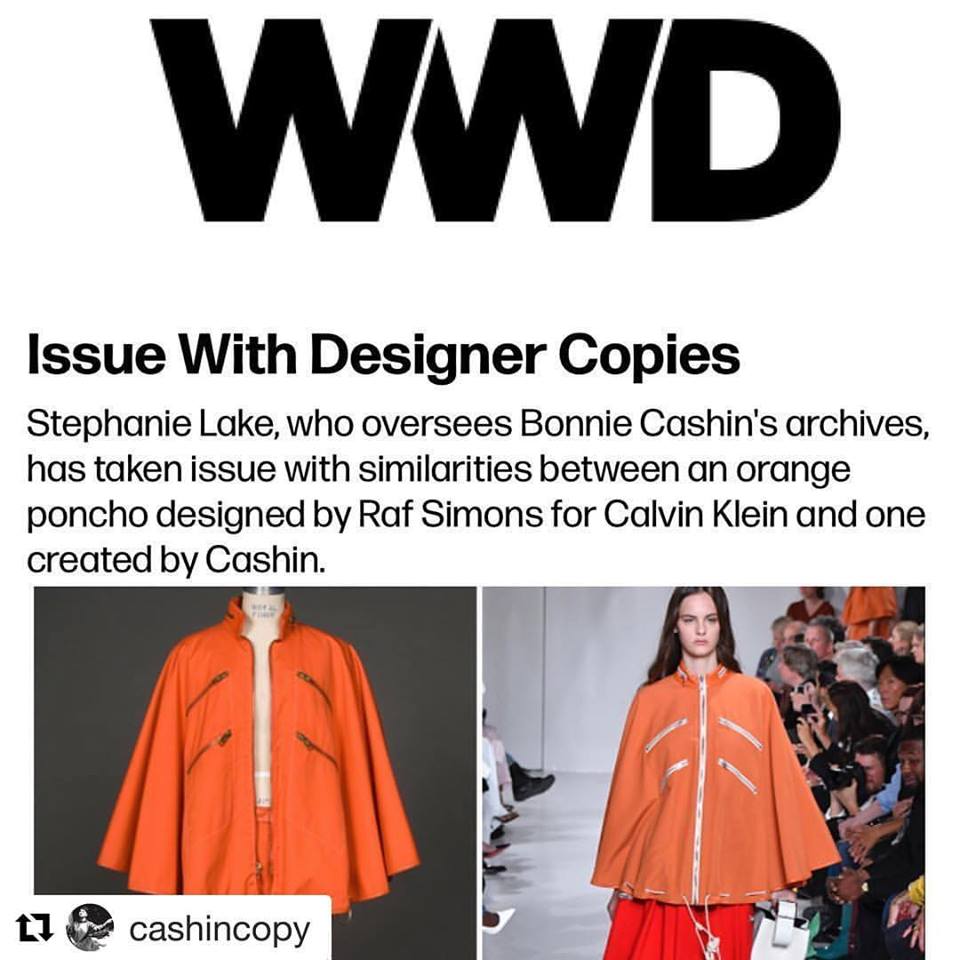Bonnie Cashin Archivist Takes Issue with Designer Copies
February 25, 2025 – Lynsey Cawdle


By Rosemary Feitelberg on September 21, 2017
 Bonnie Cashin's 1976 poncho design and one from Raf Simons' Calvin Klein spring 2018 collection.
Bonnie Cashin's 1976 poncho design and one from Raf Simons' Calvin Klein spring 2018 collection.As the owner of the Bonnie Cashin Archives, Stephanie Lake decided long ago that she wasn’t going to be “policing” copycats. That decision was made despite years of being “sad, frustrated and angered” from seeing Cashin’s work knocked off every season and not being credited.
But after seeing a blog post of a side-by-side comparison of an orange poncho with four zippers from the Calvin Klein spring 2018 collection by Raf Simons next to a 1976 one by Cashin, Lake took action. She turned to Instagram to create the account @cashincopy, described as “A project of the Bonnie Cashin archive” which highlights “absolute copies, things that are written about her, and where there is influence or inspiration but the designers and brands don’t cite her.”

A post from @cashincopy’s Instagram.
The look in question was created in as part of a 1976 Saks Fifth Avenue/International Design Conference in Aspen project, she said. Referring to Cashin’s own scrapbooks regarding the orange poncho, Lake said, “It was about biking or skating in New York City. Of course, security at that time was the reason for the color. And the big zipped pockets were so you wouldn’t need a handbag — just quintessential Cashin in its thoughtfulness.”
Executives at Calvin Klein did not respond to requests for comment.
The Instagram page also shows similarities between Cashin’s work and collections by Miu Miu, Rachel Zoe, Lisa Perry and Coach.
Cashin, who started her own sportswear company in 1952 and maintained it until 1985, also teamed with Coach in the early Sixties and served as designer there until 1974. Even in the Sixties, Cashin battled with her share of knockoffs, as documented by WWD. And a Saks Fifth Avenue press release from Cashin’s early days refers to how her layered look, storm coats, hardware closings, use of fringe and leather, tote bags and purse pockets were “firsts” that have been widely copied. Throughout her years in business, Cashin never had any investors, assistant designers or licensing deals for her name, Lake said.
“She wished that people who were copying her would do a better job. And in the Sixties she went to D.C. to campaign for designers’ rights, acknowledging that people were going to copy but the originator of the idea should by law receive credit and compensation,” Lake said.

A post from @cashincopy’s Instagram.
“Coach was a very small part of her life but the company will always live under her shadow. Everything she brought to that company are the hallmarks today.…The average person buying a bag there is never going to realize the history of that or know who she was,” Lake asserted. “The contracts that she had with Gail Manufacturing that made Coach in every single contract, every design, every sketch was her property. Those were never sold to Coach. So it is really the same as any other company reissuing, or copying or reinterpreting her design. It’s more complex but at its core, it’s the same principle.”
Asked about Lake’s view, a Coach spokeswoman said, “Coach is proud of our history and association with Bonnie Cashin, and we are pleased to celebrate that legacy.”
The poncho comparison, as well as a recent Coach design and an inquiry from Nora Veerman, a design scholar and writer who worked on this year’s “Margiela: The Hermès Years” exhibition at Antwerp’s ModeMuseum, have made Lake want to dive deeper into the Cashincopy concept with a museum exhibition.